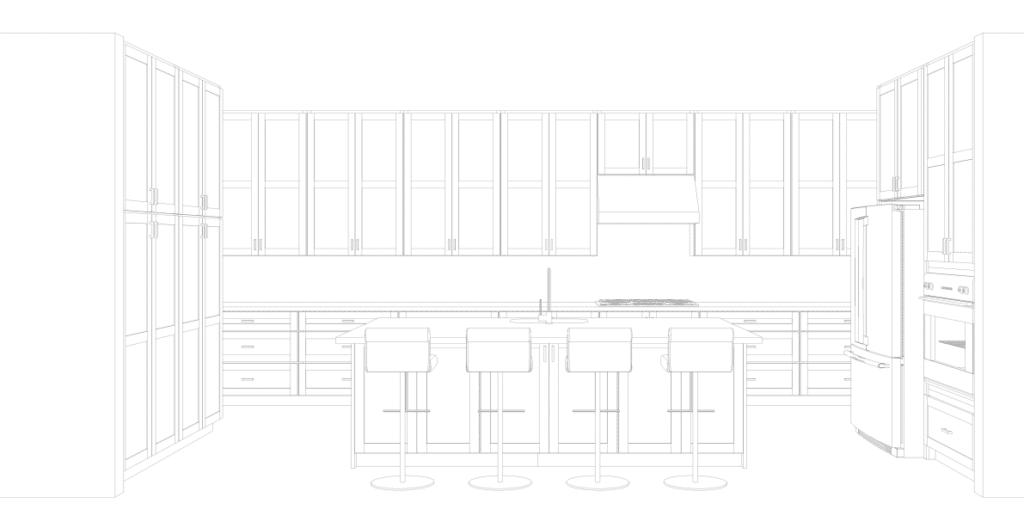Episode 51
Paul McAlary critiques Tim’s kitchen design, advising against using 54 inch wall cabinets and suggesting alternatives like 36-inch cabinets with 12-inch or 15-inch upper cabinets and 3-inch molding. He recommends reducing cabinet height to 8.5 feet for standard sizes, which could save significant costs. Paul also suggests repositioning the stove and oven for better layout, using a wider hood than the cooktop, and considering a built-in microwave. He emphasizes the importance of symmetry and proper cabinet configuration. The conversation highlights the potential cost savings and design improvements by opting for standard cabinet sizes and avoiding custom options.
Tim initial design below

Paul’s changes below

Action Items
- [ ] Send a hand-drawn sketch of the revised layout suggestions.
- [ ] Reconsider the cabinet sizes, reducing the height to 36 inches with 12-inch cabinets above.
- [ ] Reposition the oven cabinet to the corner and move the stove closer to the sink.
- [ ] Explore a wider hood option, potentially 42 or 48 inches, to better match the cooktop size.
- [ ] Review the drawer sizes and consider a 15-inch cabinet for cutlery instead of a 12-inch.
- [ ] Decide on a single-basin sink instead of a double-bowl sink.
- [ ] Explore the option of running the countertop material up the backsplash for a seamless look.
- [ ] Determine the placement and integration of the microwave, either as a built-in or on the countertop.
Outline
Cabinet Height and Design Issues
- Mark Mitten questions the use of expensive 54-inch cabinets and suggests calling Paul McAlary for better alternatives.
- Paul McAlary inquires about the ceiling height, noting the 10-foot height over the island and 9-foot height over the cabinetry.
- Paul advises against taking cabinets all the way to the 9-foot ceiling, suggesting a 3-inch molding to make the cabinets 3 inches smaller.
- Paul explains that 48-inch high wall cabinets are not standard and often force customers into expensive custom cabinet brands.
Alternative Cabinet Heights and Molding
- Paul recommends using 36-inch cabinets with a 12-inch cabinet on top and 6 inches of molding for a more proportionate look.
- He suggests using 36-inch and 15-inch cabinets with a 3-inch molding for a more contemporary and stylish appearance.
- Paul advises against having cabinets go all the way to the soffits, as this style died out in the 1970s.
- Speaker 2 agrees with Paul’s suggestions and acknowledges the need for better design.
Cabinet Brand and Design Adjustments
- Speaker 2 mentions using a free online tool called Softcabinets for initial design work and receiving suggestions from a designer.
- Paul expresses his preference for Shiloh cabinets but advises against using 48-inch high wall cabinets.
- Paul suggests reducing cabinet height to 36 inches and 12 inches or 15 inches with a 3-inch molding for a more cost-effective and stylish design.
- Paul points out discrepancies in the design, such as the placement of pantries and the need for more counter space near the stove.
Countertop and Appliance Placement
- Paul advises moving the stove to a corner and creating a breakfast bar or wine bar in its place.
- He suggests moving the oven cabinet to a pantry in the corner and making the refrigerator built-in with a panel on the side.
- Paul recommends having the hood wider than the cooktop for a more proportional look, as most kitchen designers do not know this.
- He advises using a 36-inch or 48-inch hood to make the kitchen look better.
Drawer and Cabinet Configuration
- Paul suggests making the bottom cabinets and top cabinets align for a more symmetrical and visually appealing design.
- He recommends using drawers for the bottom cabinets under the cooktop to hide the bottom of the cooktop and the face of the cooktop.
- Paul advises breaking up the cabinets into 18-inch, 36-inch, and 18-inch sections for better accessibility and symmetry.
- He emphasizes the importance of having drawers on both sides of the stove for easy access to cooking tools.
Cost-Saving Measures and Customization
- Paul explains that 80% of the cost of a cabinet is the doors, so having doors face out on the back of the island is not significantly more expensive.
- He advises against using 54-inch cabinets, as they are expensive and look out of place.
- Paul suggests lowering the ceiling height to 8.5 feet to use standard 36-inch high cabinets with 6 inches of molding on top.
- He explains that using standard cabinet sizes from less expensive brands can save a significant amount of money compared to custom cabinets.
Microwave and Appliance Storage
- Paul suggests using a built-in microwave cabinet instead of having it on the countertop.
- He explains that custom trim kits are available for any size microwave and are relatively inexpensive.
- Paul advises against having a built-in microwave with an expensive trim piece, as it can be cost-prohibitive.
- He suggests using a speed oven, which is a combination microwave and convection oven, for more functionality.
Designer’s Role and Customer Expectations
- Paul criticizes designers who simply regurgitate the customer’s plan without offering professional advice.
- He emphasizes the importance of experienced designers who can provide valuable input and cost-saving suggestions.
- Paul advises looking for independent kitchen places that offer craft-made cabinets and have experienced designers.
- He explains that craft-made dealers often have higher-paid designers who can provide better value and competitive pricing.
Final Recommendations and Next Steps
- Paul offers to send hand drawings to help visualize the suggested design changes.
- He advises Speaker 2 to consider the cost implications of using custom cabinets versus standard sizes.
- Paul suggests calling him again if the design progresses further for additional advice.
- Speaker 2 thanks Paul for his insights and agrees to follow up if needed.
x
Call into our Friday helpline and podcast most Fridays between 2 and 4 pm Eastern Standard Time. We review designs and give design help. Call 61O-5OO-4O71 then leave a message and we will call you when a line opens. Be ready to email designs or measurements you want Paul to consider.
This Podcast is brought to you by Brighton Custom Cabinetry. Craftmanship, quality, and customization made more affordable.

Paul
Paul’s bio from the magazine Kitchen and Bath Design News:
Paul McAlary possesses a voice that resonates far beyond the boundaries of Philadelphia’s western suburbs and the city’s prestigious Main Line – the location of his well-established Delaware Valley design firm.
McAlary, president and senior designer of Bala Cynwyd, PA-based Main Line Kitchen Design, is an internationally recognized kitchen design authority who has won more than a dozen local and national design awards, including being named a 2017 Viking Appliances Designer of Distinction.
Beyond his achievements as a designer, McAlary has also forged a burgeoning reputation as the creative force behind the “Main Line Kitchen Design Blog,” a unique online forum and social media resource that is read by more than 40,000 people each month and has been honored as one of the top kitchen design blogs in the world. Main Line Kitchen Design’s videos and blogs address a wide range of kitchen/bath-related topics aimed at sparking a constructive exchange of ideas among both consumers and design professionals.
McAlary, whose kitchens and comments often appear in trade magazines and on social media sites, is sometimes at odds with the kitchen design establishment, but he maintains a distinct sense of humor and is known as a fierce advocate for design standards, ethics and transparency in the kitchen design trade.
Subscribe to Main Line Kitchen Design’s Blogs and podcasts here.
Written by:
Paul Mcalary
Paul McAlary is the President of Main Line Kitchen Design in Narberth, PA. He’s been designing award winning kitchens for 25 years and can be reached at paul@mainlinekitchendesign.com

